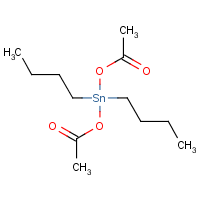Dibutyltin diacetate
Agent Name
Dibutyltin diacetate
CAS Number
1067-33-0
Formula
C12-H24-O4-Sn
Major Category
Metals

Synonyms
BA 2726; Bis(acetyloxy)dibutylstannane; Di-n-butyltin diacetate; Diacetoxybutyltin; Diacetoxydibutylstannane; Diacetoxydibutyltin; Dibutyl tin diacetate; Dibutylstannium diacetate; Fomrez sul-3; Stannane, bis(acetyloxy)dibutyl-; Stannane, diacetoxydibutyl-; T 1; T 1 (Catalyst); T 1 (VAN); Tin, dibutyl-, diacetate; [ChemIDplus] UN2788 (liquid); UN3146 (solid);
Category
Tin Compounds, Organic
Description
Clear yellow liquid; [Hawley] Colorless or yellow liquid; mp = 10 deg C; [HSDB] Colorless liquid; [MSDSonline]
Sources/Uses
Used as stabilizer for polyvinyl chloride, a catalyst for manufacturing silicone and urethane foams, and a curing agent for silicone elastomers; [HSDB]
Comments
Rats given 1/4 the LD50 dose daily for 10 days developed signs of hepatotoxicity; Oral LD50 (rat) = 32 mg/kg; [HSDB] May cause skin rashes; Can be absorbed through skin; [CAMEO] An irritant; [MSDSonline] See "Tin, organic compounds."
Biomedical References
Exposure Assessment
Skin Designation (ACGIH)
Yes
TLV (ACGIH)
0.1 mg/m3, as Sn
STEL (ACGIH)
0.2 mg/m3, as Sn
PEL (OSHA)
0.1 mg/m3, as Sn
MAK
0.02 mg/m3, inhalable fraction, as Sn
IDLH (NIOSH)
25 mg/m3, as Sn
Vapor Pressure
1.3 mm Hg
Explanatory Notes
The Guide in the Emergency Response Guidebook is for "Organotin compound, liquid, n.o.s." Organic tin compounds have a "skin" designation and are classified as "A4" (Not classifiable as human carcinogen); [ACGIH]
Adverse Effects
Neurotoxin
Other CNS neurotoxin
Hepatotoxin
Hepatoxic (a) from occupational exposure (secondary effect) or (b) in animal studies or in humans after ingestion
ACGIH Carcinogen
Not Classifiable
Diseases, Processes, and Activities Linked to This Agent
Processes
Industrial Processes with risk of exposure: